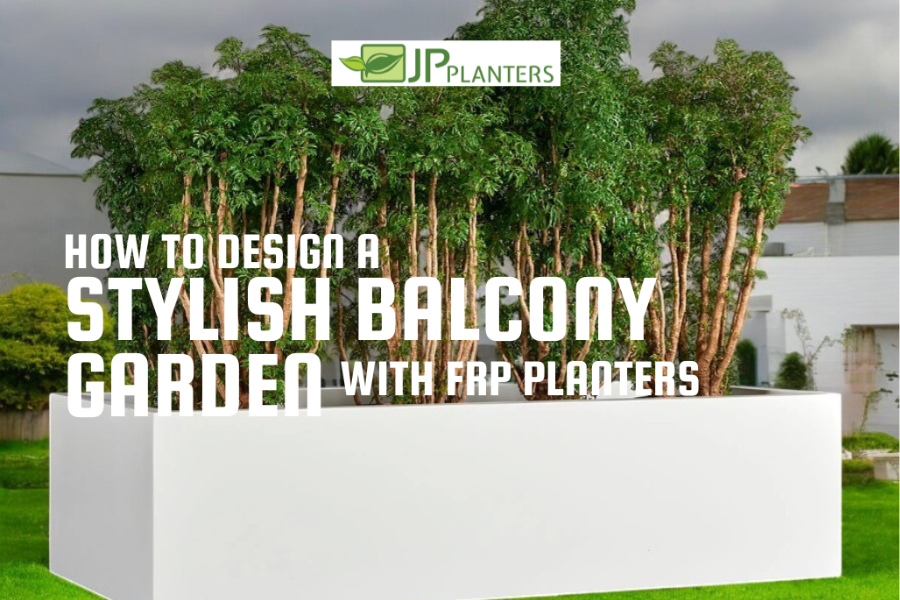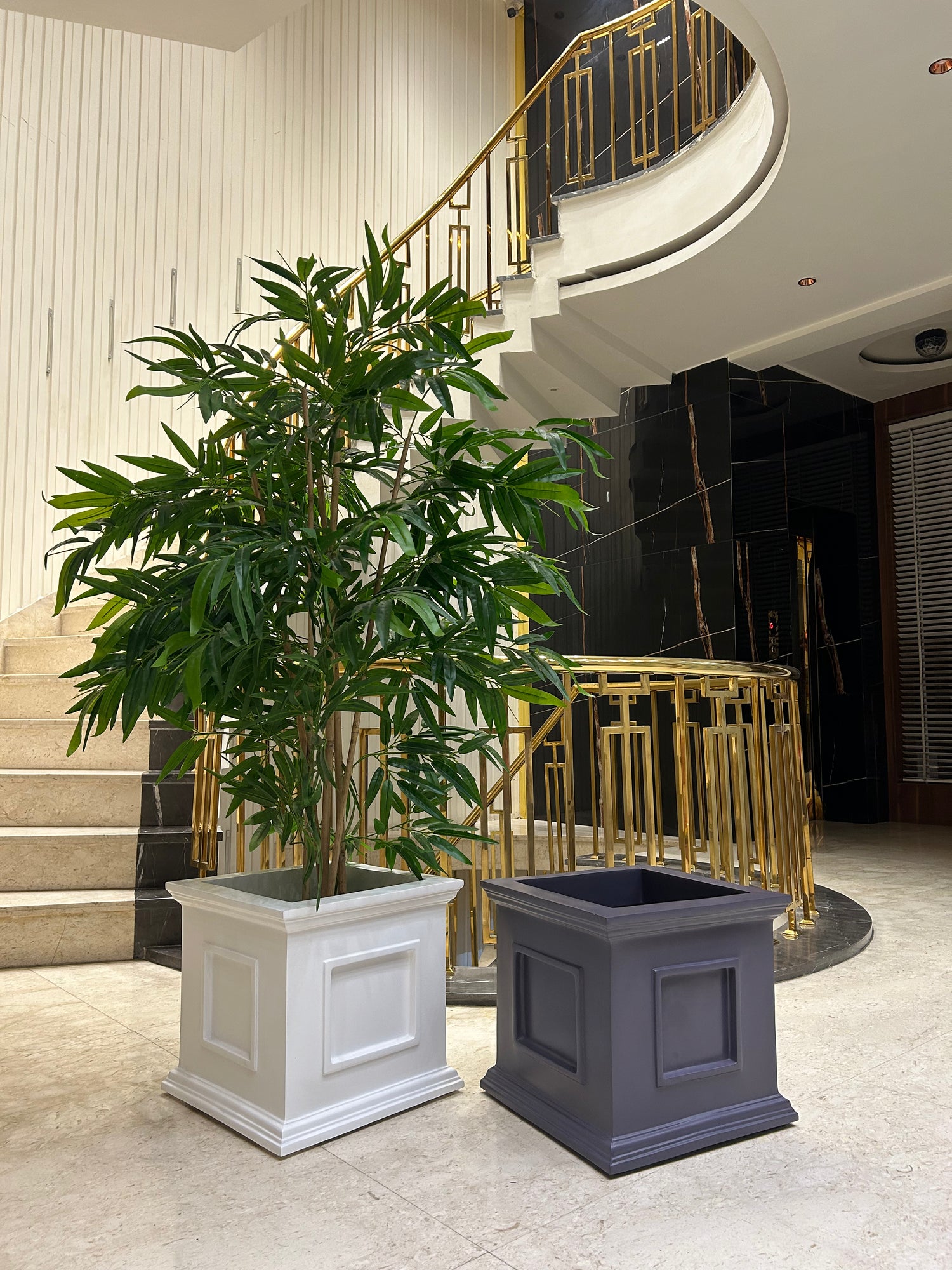
How to Design a Stylish Balcony Garden with FRP Planters
Share
Creating a stylish balcony garden in a small urban space can transform a simple balcony into a serene oasis. Whether you live in a bustling city apartment or a cozy townhome, balcony gardens offer an opportunity to connect with nature, even in limited spaces. One of the best tools for maximizing beauty and functionality in these small spaces is the use of FRP planters (Fiber Reinforced Plastic planters). Known for their lightweight durability and sleek designs, FRP planters are an excellent choice for balcony gardens that require both style and resilience.
Why Choose FRP Planters for Small Spaces?
FRP planters are gaining popularity for their many advantages in balcony gardening. Here’s why FRP planters stand out as an ideal option for outdoor planters, especially when space is at a premium:
- Durability: FRP planters are highly resistant to cracking, fading, and chipping, even under challenging weather conditions. Unlike ceramic or terracotta, they won’t become brittle in cold temperatures, making them a long-lasting choice for balcony gardening.
- Lightweight Design: Moving planters around can be challenging on a balcony, but fiber planter pots are much lighter than traditional materials like stone or metal. This makes them easy to rearrange, allowing you to change your layout seasonally or adapt your garden as your plant collection grows.
- Sleek, Versatile Styles: FRP planters come in various colors, shapes, and finishes, enabling you to match your personal style—whether minimalist, modern, or rustic. They provide a clean, polished look that blends seamlessly with any balcony aesthetic.
Choosing FRP Planters for Small Spaces
When selecting FRP planters for your balcony, there are a few essential considerations to keep in mind. Here’s how to make the best choices to suit your small-space needs:
- Size and Shape: Look for planters that fit the scale of your balcony. Tall, narrow planters maximize vertical space, allowing for multiple plants without encroaching on floor space. Rectangular or oval planters can be placed along railings, creating a natural barrier while enhancing privacy.
- Drainage: Ensure your planters have adequate drainage to prevent over-watering, especially in outdoor settings. FRP planters often come with pre-drilled drainage holes, but if they don’t, adding your own is a simple modification to keep plants healthy.
- Color Selection: Choose colors that reflect the style of your space. Dark hues like charcoal or navy can add sophistication, while light shades can create a breezy, open feel. Matching the planters to your balcony’s decor will make the space feel unified.
Selecting Plant Types for FRP Balcony Planters
The right plant selection can turn your balcony into a vibrant, lush escape. Here are some tips for choosing plants that thrive in FRP planters while creating a beautiful, sustainable space:
- Consider Sunlight: Determine how much sunlight your balcony receives and select plants accordingly. For a sunny balcony, options like lavender, rosemary, and succulents work well. Shadier spots benefit from shade-loving plants like ferns, pothos, and peace lilies.
- Size and Growth Habit: Choose a mix of plants with varying heights and growth habits to create visual interest. Taller plants like snake plants or ornamental grasses work well in the back, while compact flowering plants or trailing vines like petunias and ivy add depth and texture in the foreground.
- Low-Maintenance Varieties: Since balconies can be exposed to temperature changes, it’s helpful to pick hardy, low-maintenance plants. Succulents, herbs, and evergreens are excellent choices for easy balcony gardening.
Arrangement Tips for a Cohesive Design
To make the most of your FRP planters and create a cohesive look, follow these arrangement tips:
- Layer Heights: Arrange planters by height to build a sense of depth. Place taller plants in the back or near walls, medium-sized plants in the middle, and shorter plants along the front edge. This layering not only looks attractive but also ensures each plant gets adequate light.
- Group by Style or Color: For a sleek look, group plants with similar colors, such as varying shades of green or a monochromatic scheme. Alternatively, try a colorful mix of flowers to add vibrancy to the space.
- Use Vertical Space: Balcony space is often limited, so make use of vertical space. Hang small FRP planters on railings or use a vertical planter stand to add greenery without taking up floor area. Vertical gardens are perfect for herbs or trailing plants, adding both beauty and practicality.
- Create Focal Points: Highlight one or two large planters as focal points. Place them in the corners or at the far end of the balcony to draw the eye and make the space feel more expansive.
Maintenance Essentials for FRP Planters
Keeping your balcony plants healthy and thriving requires regular care, but FRP planters can make this easier. Here are some essential maintenance tips:
- Watering: FRP planters often retain moisture well, meaning you won’t have to water as frequently. Check soil moisture levels before watering, especially in cooler months.
- Cleaning: FRP is easy to clean and doesn’t stain easily, making maintenance simple. Wipe down planters with a damp cloth periodically to keep them looking fresh and polished.
- Seasonal Adjustments: During colder months, you may want to bring some plants indoors or switch to hardier varieties. FRP planters are light enough to move, allowing you to protect delicate plants without too much hassle.
Comparing FRP Planters to Other Balcony Planter Materials
|
Feature |
FRP Planters |
Metal Planters |
Ceramic Planters |
Terracotta Planters |
|
Durability |
High; resistant to weathering |
Moderate; prone to rust |
Moderate; can crack |
Moderate; can crack |
|
Weight |
Lightweight |
Heavy |
Heavy |
Moderate |
|
Aesthetic Appeal |
Sleek and modern, versatile colors |
Industrial look |
Traditional, colorful |
Earthy, rustic |
|
Maintenance |
Low; easy to clean |
Requires anti-rust treatment |
Can stain; harder to clean |
Prone to water stains |
Practical Tips for Designing Your Balcony Garden on a Budget
- Start Small: Begin with just a few fiber planter pots and add more as your garden grows.
- DIY Decor: Use items like string lights, decorative stones, or hanging baskets to add character without spending a lot.
- Opt for Multipurpose Plants: Herbs like basil, mint, and parsley can beautify your space and add fresh flavor to your cooking.
Conclusion
Designing a stylish balcony garden with FRP planters can transform your outdoor space into a functional and visually appealing retreat. With their lightweight durability, sleek aesthetics, and easy maintenance, FRP planters are an ideal choice for balcony gardening. By selecting the right plants, arranging them thoughtfully, and maintaining them with care, you can create a serene urban oasis. So, take a bold step and experiment with FRP planters—your balcony garden awaits its elegant transformation!




